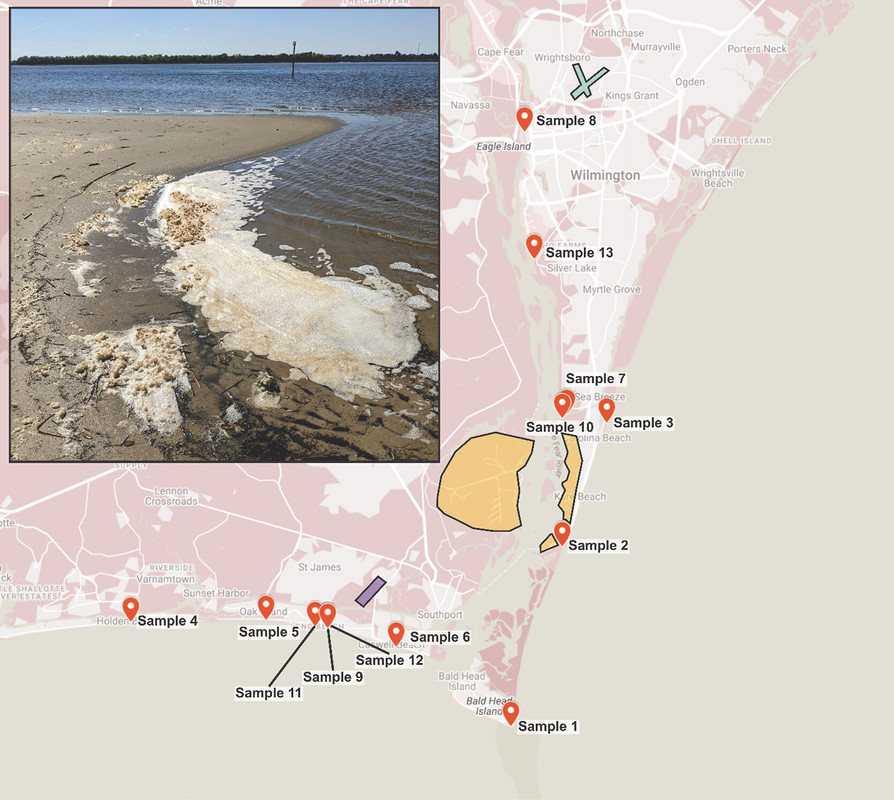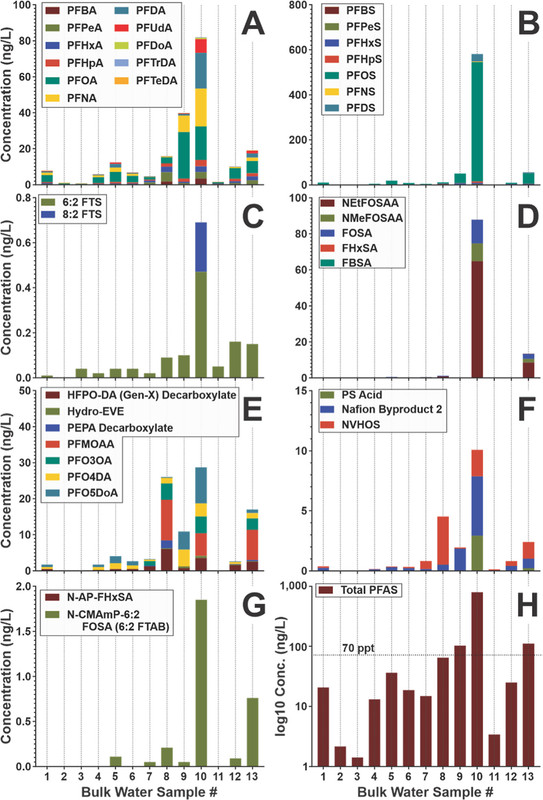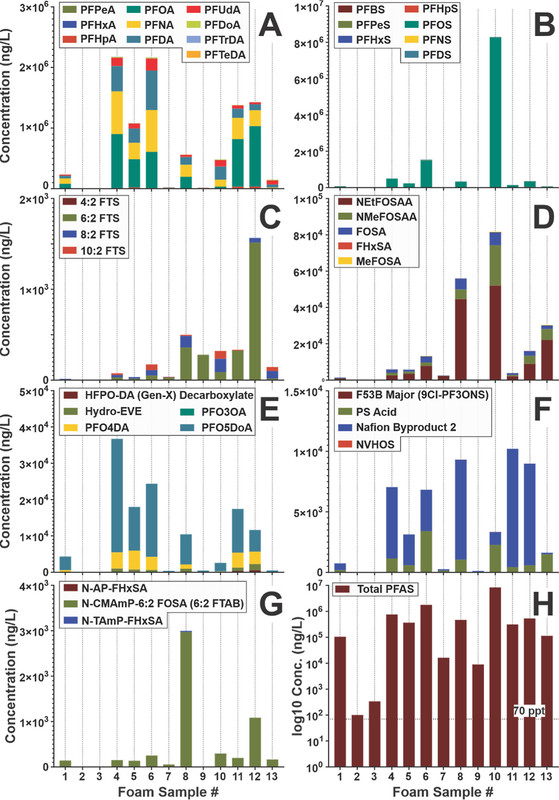Environment & Energy
Showing Original Post only (View all)Perfluorinated Toxic Fuel Cell Byproduct Detected in North Carolina Seawater. [View all]
I have very little time to discuss this interesting paper from the group of the famous (to mass spec people) scientist Erin Baker but I'll make a quick note of it. The paper is this one: Detection and Quantitation of Per- and Polyfluoroalkyl Substances in North Carolina Sea Foam and the Corresponding Sea Water Jeffrey R. Enders, Rebecca A. Weed, Emily Donovan, Drake Phelps, Grace Campbell, Katlyn May, and Erin S. Baker Environmental Science & Technology 2025 59 (35), 18831-18845.
Dr. Baker is a world leader in the development of ion mobility spectrometry, a very powerful tool in proteomics (with which I am professionally involved) as well as in the study of the broad class of highly problematic, highly variable, and widely distributed perfluoroalkylated substances, PFAS. A subset of these contaminants are found in Nafion, a polymer widely used in the hydrogen fuel cells that the fossil fuel industry likes to advertise here and elsewhere in the effort to rebrand fossil fuels as "green."
From the introduction to the paper:
North Carolina has been especially affected by PFAS contamination due to chemical manufacturing and other industries that occur along the Cape Fear River. Many reports have identified and quantitated various PFAS at remarkable levels in environmental samples as well as biological fluids of residents. (6−10) Communities in this region remain concerned about historic and new exposures to PFAS impacting their way of life. Recently, nine United Nations human rights experts called out major PFAS producers, as well as state and federal regulators, for failing to protect residents, especially in North Carolina, from business-related human rights abuses. These studies, combined with community advocacy efforts have influenced legislature at the federal level as GenX (sometimes referred to as Hexafluoropropylene oxide dimer acid [HFPO–DA]), a PFAS found primarily in NC, has been assigned an U.S. EPA Maximum Contaminant Level of 10 parts per trillion (ppt). Some of the PFAS identified in these studies are particularly pertinent to North Carolina as these compounds are predominantly produced/discharged from chemical manufacturing plants located in this area. These compounds include (but are not limited to) GenX, PFMOAA, PEPA, PMPA, PFO2HxA, PFO3OA, PFO4DA, (11) PFO5DoA, (11) Nafion Byproduct 1 (PS Acid), Nafion Byproduct 2, NVHOS, and Hydro-EVE. (12) In a consent order between the North Carolina Department of Environmental Quality, Cape Fear River Watch and Chemours, Chemours was required to provide reverse osmosis drinking water systems for homes in Bladen County with drinking water wells contaminated with greater than 70 ppt total PFAS or 10 ppt of any individual PFAS from a select list of PFAS (including PFMOAA, PMPA, PFO2HxA, PEPA, PFO3OA, PFO4DA, Nafion Byproduct 1 [PS Acid], Nafion Byproduct 2, PFO5DoA, PFHpA and GenX) known to occur primarily in this region. (13)...
I added the bold.
In this work, as stable isotope labeled standards were available for the 49 compounds evaluated in seawater and seafoam, IMS was not employed. The Mass Spec in question was a run of the mill Orbitrap, the Exploris 240. (Not my favorite mass spec.)
I'll have to jump right to graphics, since I have little time for a complete description:

The caption:

The caption:

The caption:
An excerpt related to Nafion by products:
I added the bold, italics and underlining.
The toxicological import of Nafion byproducts is described here among other places:
Justin M. Conley, Christy S. Lambright, Nicola Evans, Elizabeth Medlock-Kakaley, Donna Hill, James McCord, Mark J. Strynar, Leah C. Wehmas, Susan Hester, Denise K. MacMillan, L. Earl Gray, Developmental toxicity of Nafion byproduct 2 (NBP2) in the Sprague-Dawley rat with comparisons to hexafluoropropylene oxide-dimer acid (HFPO-DA or GenX) and perfluorooctane sulfonate (PFOS), Environment International, Volume 160, 2022, 107056
The fossil fuel industry in its efforts to greenwash itself is a big promoter of the idea of "green hydrogen," which is effectively a lie, since only a trivial amount of hydrogen is generated by electrolysis, in most cases using grid electricity, the majority of which is still generated using dangerous fossil fuels, adding on the thermodynamic penalty wherein exergy is destroyed merely by generating electricity. This fraudulent bit of marketing utilizes the mistaken belief that so called "renewable energy" is a significant form of energy - it isn't in most places - and that so called "renewable energy" is sustainable and clean, also not true.
Part of this marketing is the claim that fuel cells are sustainable. The requirement for the precious metal platinum in fuel cells - all the hype about precious metal free fuel cells notwithstanding - means that fuel cells are not sustainable except in rather rare applications, where they are expensive but unavoidable.
I would note that the issue with PFAS, in particular the Nafion byproducts suggests that fuel cells, even if they don't explode and burn, are not safe either. The world can't afford them, but there are many things that the world can't afford in use. It would be better to cut the whole thing off before it starts killing a lot of people, fish, and other fauna.
Have a nice day tomorrow.